This is the story of the craziest day I’ve had so far in Tanzania.
It was my fifth consecutive day with K1, a group of more than thirty red-tail monkeys. After four, fourteen-hour days behind me already, I was struggling to keep up with the group from the beginning of the day.
The monkeys were already making things difficult that morning, traveling higher and higher up the slope of Mchungwa valley, entering thickets impassible by humans, and spreading out so much that it was impossible to see more than a few monkeys at a time.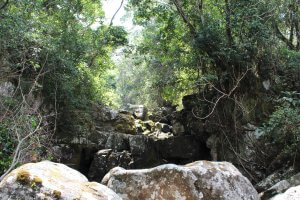 Just as Judi, my field assistant for the day, and I sat down next to a thicket, thinking the monkeys were finally going to settle down for a few minutes, chimps materialized just ten meters away. We hadn’t heard them coming. Nor did they make any sounds as they climbed a tree, watching us as they settled into comfortable sitting positions. There was a female, her infant, and a juvenile. A bit further down the slope, we saw even more chimps popping up into the trees. By this time, most of the monkeys had melted into the tangle of vines covering the upper portions of the mountainside. Although chimpanzees rarely consume red-tailed monkeys (in fact – we have yet to observe the chimps preying on red-tails at this study site), our monkeys do not take any chances.
Just as Judi, my field assistant for the day, and I sat down next to a thicket, thinking the monkeys were finally going to settle down for a few minutes, chimps materialized just ten meters away. We hadn’t heard them coming. Nor did they make any sounds as they climbed a tree, watching us as they settled into comfortable sitting positions. There was a female, her infant, and a juvenile. A bit further down the slope, we saw even more chimps popping up into the trees. By this time, most of the monkeys had melted into the tangle of vines covering the upper portions of the mountainside. Although chimpanzees rarely consume red-tailed monkeys (in fact – we have yet to observe the chimps preying on red-tails at this study site), our monkeys do not take any chances.
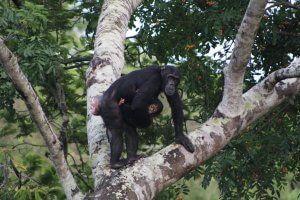 Along with the arboreal chimps, we could hear a few individuals screaming and running through the underbrush below us. So, there we were – stuck between a group of chimps and the impassible thickets. There was nothing to do but wait until the chimpanzees had moved further away so we could slide down the slope and try to find our way back to the monkeys, wherever they had fled.
Along with the arboreal chimps, we could hear a few individuals screaming and running through the underbrush below us. So, there we were – stuck between a group of chimps and the impassible thickets. There was nothing to do but wait until the chimpanzees had moved further away so we could slide down the slope and try to find our way back to the monkeys, wherever they had fled.
In the short period of time Judi and I were stuck, unable to travel, the monkeys covered a long distance. It took us another three hours to find them, travelling so far along the valley that the mountainsides gave way to a plateau. Jubilant at finding the monkeys again, we got back to data collection. For me, that meant recording and collecting plant samples of the food items the monkeys were consuming. As I stopped to collect a sample of a new woodland plant that a monkey had nibbled on, I lost the group momentarily.
When I returned to the group, I heard a chorus of chirping (the monkeys make very bird-like vocalizations) and scuffling in the underbrush. Stooping down to get a better look, I saw a group of at least eight monkeys surrounding an owl. A few monkeys simultaneously jumped on the owl, while others vocalized and watched while perched on low hanging lianas. Then a monkey darted out and pulled the owl by its wing along the forest floor. This all happened multiple times while I frantically tried to video record and narrate the frenzy of activity. The owl was pulled into a nearby dried up river bed and the monkeys hovered over it for a few more minutes, shaking lianas above the bird but producing fewer and fewer vocalizations. Finally, the monkeys bounced away, starting a game of chase on the ground.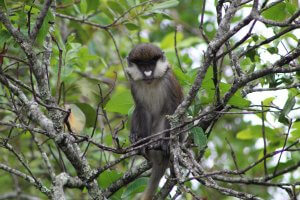 I couldn’t get down to the riverbed without navigating a circuitous route to avoid thorny vines. So, by the time I made it to the owl’s previous location, the bird had disappeared. Lucky for the bird, this meant it survived the mobbing and flew away. Unfortunately for me, the bird’s quick disappearance meant I couldn’t get a good enough picture to identify the owl species.
I couldn’t get down to the riverbed without navigating a circuitous route to avoid thorny vines. So, by the time I made it to the owl’s previous location, the bird had disappeared. Lucky for the bird, this meant it survived the mobbing and flew away. Unfortunately for me, the bird’s quick disappearance meant I couldn’t get a good enough picture to identify the owl species.
(Monkey-avian interactions are quite rare, so we are hoping to publish this anecdote as a “short communications” paper in a primatology journal. And after looking through some bird books back at camp, we think the owl is an African Wood Owl.)
The owl mobbing was unique and strange enough, but nothing compared to the rest of my day.
The monkeys had settled down a bit, so we took a seat on the forest floor. Judi had just broken out her Tupperware for a late lunch when the alarm calls began. The handful of monkeys that were wandering the forest floor shot up into the trees and the entire group started traveling quickly downriver – all the time maintaining the highest intensity alarm calls I’ve ever heard from them (their alarm calls – like their other vocalizations – are also very bird-like). The constant chirping drowns out all other sound as I rushed after them, stumbling through the rocks of the dry river bed while trying to follow the movements and sounds above me.
Then they stopped.
I looked around me, expecting to see a predator of some kind. Maybe African Wild Dogs, maybe a Jaguar. Or maybe just a bumbling bush pig that the monkeys mistook for a threat. But the intensity of the alarm calls coming from high in the trees put me on edge.
Then I saw one, then two, female lions cross the river bed a mere thirty meters ahead.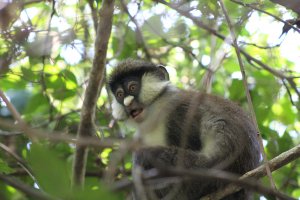
They didn’t look at me. They just plodded across the stones and disappeared, almost before I could even register what just happened. Lions hadn’t been seen in this area since 2014. Also…. those were FEMALE lions! The hunters! Even though the lions didn’t look at me, they had to have known I was there – either by smell or the noises I made stumbling through the rocks. What if there were more? The growth on either side of the river made it impossible to see what could be hiding in the foliage. I quickly used my radio to call Judi (who in the midst of her lunch hadn’t been able to pack everything and keep up) and told her what I saw and that she should probably stay put. I would make my way back to her. My heart pounded and my legs were weak as I staggered back to her. We met each other wide eyed and suck in more air than normal as we discuss our game plan. As we crept along the river bed, towards the monkeys but also possibly towards lions, we exchange nervous looks. It’s not like we were provided with lion defense training. As we made our way outside the forest and discovered no hidden lions, we laugh in relief.
“Almost any organism around lions might be a potential prey item, and for people to think that they are an exception is folly” says Luke Dollar, director of National Geographic Society’s Big Cats Initiative. “I would imagine that every other primate that co-exists with big cats is acutely aware of the position they hold relative to the top predators of the world.” Read more here.
Lions or no lions, we still had to catch back up to the monkeys.
And they were making their way down a strip of forest sidling Moporomoko Kubwa – translation: “big waterfall” (also dried up until more rains fall). Which meant we had to climb down the steepest trail in the study site – a trail that I’ve fallen down more times than not. With adrenaline still pumping, we cautiously made our way down the trail – only to find that the monkeys were nowhere in sight. Two hours spent searching the forests, up and down slopes – once again made difficult by the tangles of vines and thorny vines – yielded no monkeys. Which meant a climb back up the Moporomoko Kubwa trail in case we misread their traveling intentions. Then halfway up the trail, a downpour began. We were soaked before we could make it to the top to don our raingear. Chimp vocalizations began echoing through the surrounding woodlands and forests and we knew the chance of finding the monkeys had dropped to zero.
Red-tailed monkeys don’t like the rain and they don’t like chimps.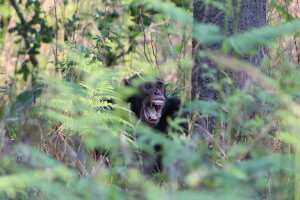
Although our days don’t normally end until 7:00pm, at 4:00, on this last follow day with this group, we didn’t feel bad about heading back to camp a bit early. After a 45-minute hike in a downpour, we crashed at camp. We tell our story. Everyone is shocked. Some are a bit nervous. And almost all the foreigners are jealous about our experience and excited about the possibility of having lions back in the area.
My fingers were so numb from the cold rain that it took about 30 minutes of clutching a mug of hot tea before I could text my supervisor the news of the day. With too many details to fit in one text, I basically just bullet point the day. The next day I typed everything out – as scientifically as possible.
A month and a half later, I’m finally typing out the narrative form. Lion encounters and the owl event are rare occurrences here (although there were several lion sightings over the course of the next week – I even saw some lion prints and scat a week later). But the rain, chimps, and treacherous hiking are very typical indeed.
I hope this paints a picture of how unexpected life in the field can be.


That is an absolute amazing day!!! Glad you’re getting to do what you love!!!
Christopher,
We love reading your posts! Such beautiful writing and descriptions that make me feel like I’m there too! What a wonderful, streneous adventure you are on! I know you’re learning tons and I can’t wait to hear all of your stories when you return home! Keep learning and writing! I know you’re going to be famous one day on national Geographic or something spectacular! We are so proud of you and pray for you daily! Love, The Passes